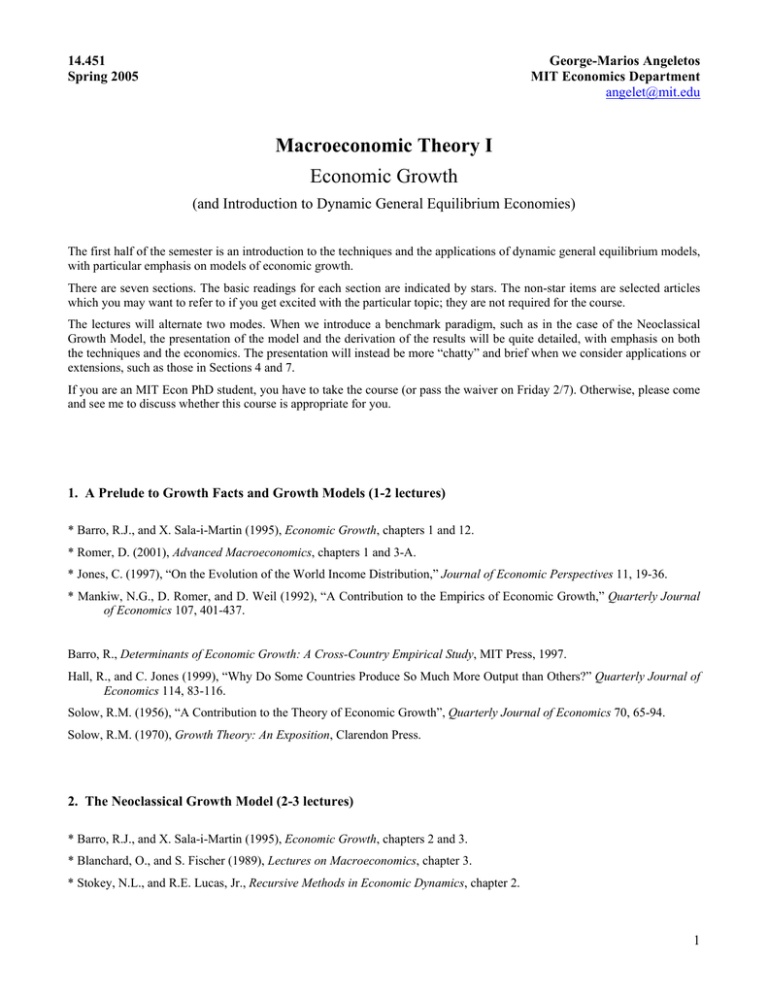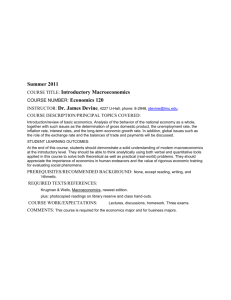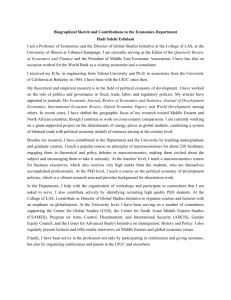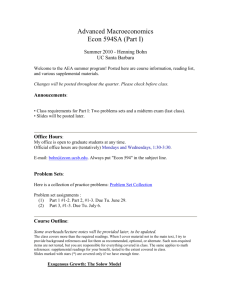Macroeconomic Theory I
advertisement

14.451 Spring 2005 George-Marios Angeletos MIT Economics Department angelet@mit.edu Macroeconomic Theory I Economic Growth (and Introduction to Dynamic General Equilibrium Economies) The first half of the semester is an introduction to the techniques and the applications of dynamic general equilibrium models, with particular emphasis on models of economic growth. There are seven sections. The basic readings for each section are indicated by stars. The non-star items are selected articles which you may want to refer to if you get excited with the particular topic; they are not required for the course. The lectures will alternate two modes. When we introduce a benchmark paradigm, such as in the case of the Neoclassical Growth Model, the presentation of the model and the derivation of the results will be quite detailed, with emphasis on both the techniques and the economics. The presentation will instead be more “chatty” and brief when we consider applications or extensions, such as those in Sections 4 and 7. If you are an MIT Econ PhD student, you have to take the course (or pass the waiver on Friday 2/7). Otherwise, please come and see me to discuss whether this course is appropriate for you. 1. A Prelude to Growth Facts and Growth Models (1-2 lectures) * Barro, R.J., and X. Sala-i-Martin (1995), Economic Growth, chapters 1 and 12. * Romer, D. (2001), Advanced Macroeconomics, chapters 1 and 3-A. * Jones, C. (1997), “On the Evolution of the World Income Distribution,” Journal of Economic Perspectives 11, 19-36. * Mankiw, N.G., D. Romer, and D. Weil (1992), “A Contribution to the Empirics of Economic Growth,” Quarterly Journal of Economics 107, 401-437. Barro, R., Determinants of Economic Growth: A Cross-Country Empirical Study, MIT Press, 1997. Hall, R., and C. Jones (1999), “Why Do Some Countries Produce So Much More Output than Others?” Quarterly Journal of Economics 114, 83-116. Solow, R.M. (1956), “A Contribution to the Theory of Economic Growth”, Quarterly Journal of Economics 70, 65-94. Solow, R.M. (1970), Growth Theory: An Exposition, Clarendon Press. 2. The Neoclassical Growth Model (2-3 lectures) * Barro, R.J., and X. Sala-i-Martin (1995), Economic Growth, chapters 2 and 3. * Blanchard, O., and S. Fischer (1989), Lectures on Macroeconomics, chapter 3. * Stokey, N.L., and R.E. Lucas, Jr., Recursive Methods in Economic Dynamics, chapter 2. 1 Cass, D. (1965), “Optimum Growth in an Aggregative Model of Capital Accumulation,” Review of Economic Studies 32, 233-240. Cass, D. (1966), “Optimum Growth in an Aggregative Model of Capital Accumulation: A Turnpike Theorem,” Econometrica 34, 833-850. Lucas, R.E., Jr. (1990), “Why Doesn't Capital Flow from Rich to Poor Countries?” American Economic Review 80, 92-96. Ramsey, F.P. (1928), “A Mathematical Theory of Saving,” Economic Journal 38, 543-559. Romer, D. (2001), Advanced Macroeconomics, part A of chapter 2. Skiba, A.K. (1978), “Optimal Growth with a Convex-Concave Production Function,” Econometrica 46, 527-539. 3. Applications I: Business Cycles, Asset Pricing, Public Finance, Overlapping Generations, Behavioral (2-3 lectures) * Blanchard, O., and S. Fischer (1989), Lectures on Macroeconomics, chapter 3, sections 5.1-5.2, sections 10.1 and 11.3. * Barro, R.J., and X. Sala-i-Martin (1995), Economic Growth, chapter 3 and appendix to chapter 3. * Stokey, N.L., and R.E. Lucas, Jr., Recursive Methods in Economic Dynamics, chapter 2. * Lucas, R.E, Jr. (1978), “Asset Prices in an Exchange Economy,” Econometrica 46, 1429-1445. * Diamond, P. (1965), “National Debt in a Neoclassical Growth Model,” American Economic Review 55, 1126-1150. * Barro, R.J (1974), “Are Government Bonds Net Wealth?” Journal of Political Economy 82, 1095-1117. * Blanchard, O. (1985), “Debt, Deficits and Finite Horizons,” Journal of Political Economy 93, 223-247. * Barro, R. (1999), “Ramsey Meets Laibson in the Neoclassical Growth Model,” Quarterly Journal of Economics 114, 11251152. Abel, A., and O. Blanchard (1983), “An Intertemporal Equilibrium Model of Saving and Investment,” Econometrica 51, 675692. Barro, R.J. (1979), “On the Determination of the Public Debt,” Journal of Political Economy 87, 940-71. Baxter, M., and R. King (1988), “Fiscal Policy in General Equilibrium,” American Economic Review 78, 315-334. Chari, V.V., and P. Kehoe (1999), “Optimal Fiscal and Monetary Policy,” NBER Working Paper 6891. King, R., and S. Rebelo (1999), “Resuscitating Real Business Cycles,” in M. Woodford and J. Taylor, ed., Handbook of Macroeconomics. Kydland, F., and E.C. Prescott (1982), “Time to Build and Aggregate Fluctuations,” Econometrica 50, 1345-1370. Laibson, D. (1997), “Golden Eggs and Hyperbolic Discounting,” Quarterly Journal of Economics 112, 443-478. Lucas, R.E, Jr., and N.L. Stokey (1983), “Optimal Fiscal and Monetary Policy in an Economy without Capital,” Journal of Monetary Economics 12, 55-93. Modigliani, F. (1986), “Life Cycle, Individual Thrift, and the Wealth of Nations,” American Economic Review 76, 297-313. Romer, D. (2001), Advanced Macroeconomics, chapter 2, part B, and chapter 7. Samuelson, P.A. (1958), “An Exact Consumption Loan Model of Interest with and without the Social Contrivance of Money,” Journal of Political Economy 1958, 467-482. Sidrausky, M. (1967), “Rational Choice and Patterns of Growth in a Monetary Economy,” American Economic Review 77, 534-544. Summers, L. (1981), “Capital Taxation and Accumulation in a Life Cycle Growth Model,” American Economic Review 71, 533-544. 2 4. Endogenous Growth I: AK, Spillovers, Human Capital (1-2 lectures) * Barro, R.J., and X. Sala-i-Martin (1995), Economic Growth, chapters 4 and 5 * Romer, P. M. (1986), “Increasing Returns and Long-Run Growth,” Journal of Political Economy 94, S1002-S1037. * Lucas, R.E., Jr. (1988), “On the Mechanics of Economic Development,” Journal of Monetary Economics 22, 3-42. * Barro, R.J. (1990), “Government Spending in a Simple Model of Endogenous Growth,” Journal of Political Economy 98, S103-S125. Aghion, P., and P. Howitt (1998), Endogenous Growth Theory, chapter 10. Caballero, R., and A. Jaffe (1993), “How High Are the Giants’ Shoulders?” NBER Macroeconomics Annual. Jones, L. and R. Manuelli (1990), “A Convex Model of Equilibrium Growth,” Journal of Political Economy 98, 1008-1038. Lucas, R.E., Jr. (1993), “Making a Miracle,” Econometrica 61, 251-272. Rebelo, S. (1991), “Long-Run Policy Analysis and Growth,” Journal of Political Economy 99, 500-521. Rivera-Batiz, L., and P. Romer (1991), “Economic Integration and Endogenous Growth,” Quarterly Journal of Economics 106, 531-556. Young, A. (1993), “Invention and Bounded Learning by Doing,” Journal of Political Economy 101, 443-472. 5. Endogenous Growth II: R&D, Innovation, Technological Change (1-2 lectures) * Barro, R.J., and X. Sala-i-Martin (1995), Economic Growth, chapters 6 and 7 * Romer, P.M. (1990), “Endogenous Technological Change,” Journal of Political Economy 98, 71-102. * Aghion, P., and P. Howitt (1992), “A Model of Growth Through Creative Destruction,” Econometrica 60, 323-351. * Acemoglu, D. (2001), “Directed Technological Change,” NBER Working Paper 8287. Acemoglu, D., and J. Ventura (2001), “The World Income Distribution,” NBER Working Paper 8083. Aghion, P., and P. Howitt (1998), Endogenous Growth Theory, chapters 1-3. Barro, R., and X. Sala-i-Martin (1992), “Public Finance in Models of Economic Growth,” Review of Economic Studies 59, 645-662. Barro, R., and X. Sala-i-Martin (1995), “Technological Diffusion, Convergence, and Growth,” Journal of Economic Growth 2, 1-26. Brezis, E., P.R. Krugman, and D. Tsiddon (1993), “Leapfrogging in International Competition: A Theory of Cycles in National Technological Leadership,” American Economic Review 83, 1211-1219 Grossman, G.M. and E. Helpman (1991), “Quality Ladders in the Theory of Economic Growth,” Review of Economic Studies 58, 43-61. Jones, C. (1995), “R&D-Based Models of Economic Growth,” Journal of Political Economy 103, 759-784. Krugman, P.R. (1979), “A Model of Innovation, Technology Transfer, and the World Distribution of Income,” Journal of Political Economy 87, 253-266. Parente, S.L., and E.C. Prescott (1994), “Barriers to Technology Adoption and Development,” Journal of Political Economy 102, 298-321. Ventura, J. (1997), “Growth and Interdependence,” Quarterly Journal of Economics 112, 57-84. 3 6. Beyond K, H, and R&D: Markets, Institutions, Wealth Distribution (1-2 lectures) * Acemoglu, D., and F. Zilibotti (1997), “Was Prometheus Unbound by Chance? Risk, Diversification, and Growth,” Journal of Political Economy 105, 709-751. * Galor, O., and J. Zeira (1993), “Income Distribution and Macroeconomics,” Review of Economic Studies 60, 35-52. * Banarjee, A., and A. Newman (1993), “Occupational Choice in the Process of Development,” Journal of Political Economy 101, 274-298. * Angeletos, G.M., and L.E. Calvet (2004), “Idiosyncratic Production Risk, Growth and the Business Cycle,” Journal of Monetary Economics. Acemoglu, D., S. Johnson and J. Robinson (2000) “The Colonial Origins of Comparative Development: An Empirical Investigation,” American Economic Review, forthcoming. Angeletos, G.M. (2004), “Idiosyncratic Investment Risk in the Neoclassical Growth Model,” MIT mimeo. Aiyagari, S.R. (1994), “Uninsured Idiosyncratic Risk and Aggregate Saving,” Quarterly Journal of Economics 109, 659-84. Bernanke, B., and M. Gertler (1989), “Agency Costs, Collateral, and Business Fluctuations,” American Economic Review 79, 87-114. Caballero, R. (1990), “Consumption Puzzles and Precautionary Saving,” Journal of Monetary Economics 25, 113-136. Caselli, F., and J. Ventura (2000), “A Representative Consumer Theory of Distribution,” American Economic Review 90, 909-926. Cole, H., G. Mailath and A. Postlewaite (1992), “Social Norms, Savings Behavior, and Growth,” Journal of Political Economy 100, 1092-1125. Greenwood, J., and B. Jovanovic (1990), “Financial Development, Growth, and the Distribution of Income,” Journal of Political Economy 98, 219-240. Obstfeld, M. (1994), “Risk-Taking, Global Diversification, and Growth,” American Economic Review 84, 1310-1329. Weil, P. (1993), “Precautionary Savings and the Permanent Income Hypothesis,” Review of Economic Studies 60, 367-383. 4






